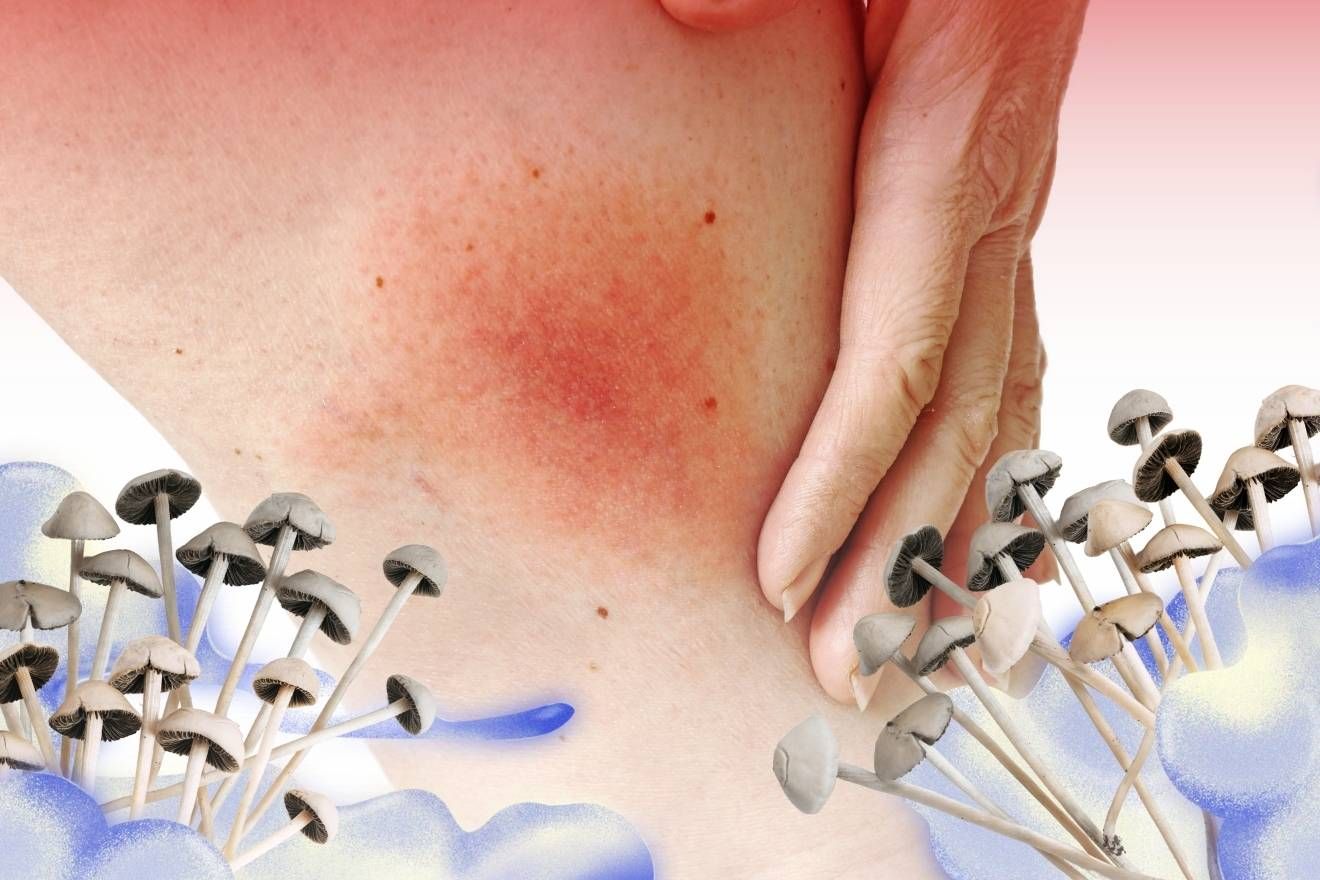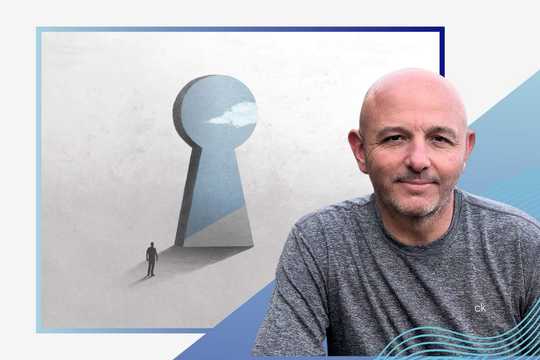Anyone who spends time in areas where black-legged ticks (deer ticks) live is at risk for Lyme disease. The majority of people recover from Lyme disease with standard treatment; however, some live with the debilitating condition, negatively impacting their physical, emotional, and mental well-being.
“Lyme disease can be a chronic and debilitating condition. Currently, available treatments do not provide sufficient relief. Psilocybin may offer a promising option.”
— Katharine Chan, MSc, BSc, PMP
Learn more about how psilocybin’s anti-inflammatory and serotonergic effects may play a promising role in treating Lyme disease.
What is Lyme Disease?
Lyme disease is an infection caused by the bacterium Borrelia burgdorferi. It primarily transmits through the bite of infected black-legged ticks, commonly known as deer ticks. Lyme disease is most prevalent in areas with large tick populations, such as the northeast, mid-Atlantic, and upper-Midwest regions of the United States.
Prevalence in the U.S.
Lyme disease is the most common vector-borne illness in the U.S. The Centers for Disease Control and Prevention (CDC) estimates that around 476,000 people are diagnosed and treated for Lyme disease each year. It is most common in states like Connecticut, Massachusetts, New York, New Jersey, Pennsylvania, and Wisconsin; however, cases have emerged in nearly every state.
Signs and Symptoms
Symptoms of Lyme disease can vary depending on the stage of the infection:
First Stage — Early Localized (Weeks One Through Four Post-Infection):
- Erythema migrans (EM): A distinctive red, expanding rash, often resembling a bullseye, at the site of the tick bite.
- Flu-like symptoms: Fever, fatigue, stiff neck, swollen lymph nodes, muscle and joint aches, and headache.
Second Stage — Early Disseminated (Months One Through Four Post-Infection):
- Rashes: Multiple rashes in different parts of the body.
- Neurological symptoms: Such as Bell’s palsy (facial drooping due to paralysis), numbness, and tingling in the limbs.
- Inflammation of the heart: This can occur, leading to irregular heartbeats (heart palpitations), dizziness, or shortness of breath.
- Heart block: In severe cases, Lyme carditis can cause heart block, a disruption in the electrical signaling between the chambers of the heart, which may require temporary pacemaker insertion.
Third Stage — Late Disseminated (After Four Months To Years Post-Infection):
- Joint inflammation: Untreated Lyme disease can lead to persistent joint inflammation, particularly in large joints like the knees. This symptom is known as Lyme arthritis.
- Swelling, pain & joint stiffness: This symptom may become chronic, leading to reduced mobility.
- Peripheral neuropathy: Tingling, numbness, or pain in the extremities.
- Encephalopathy: Memory loss, difficulty concentrating, and cognitive issues.
- Sleep disturbances and mood changes: Such as irritability, anxiety, or depression) may develop.
Diagnosis
Clinicians typically base a Lyme disease diagnosis on a combination of factors. It can be difficult to diagnose because its symptoms mimic many other conditions.
A healthcare provider will ask about your clinical history, including whether you were exposed to tick habitats and if there is the presence of an EM rash and other symptoms. Many people don’t realize or can feel if a tick bites them since it can be relatively painless.
Providers use a blood test to detect antibodies. A diagnosis requires positive tests. Testing is more accurate several weeks after infection, as antibodies take time to develop.
Treatment Options and Management
Clinicians effectively treat early-stage Lyme disease with antibiotics such as doxycycline, amoxicillin, or cefuroxime axetil for 10 to 14 days. Several factors, such as age, allergies, pregnancy status, and symptoms, can affect the length of treatment and type of antibiotic.
Patients with severe symptoms affecting the heart or nervous system may need IV antibiotics. Most people recover completely with early treatment; however, some may experience lingering symptoms known as Post-Treatment Lyme Disease (PTLD).
What is Post-Treatment Lyme Disease (PTLD)?
If a patient experiences severe symptoms for six months or more after standard antibiotic treatment, they may have a condition that medical professionals call Post-Treatment Lyme Disease (PTLD). These symptoms can include:
- Fatigue
- Muscle and joint pain
- Cognitive difficulties such as short-term memory problems, issues with multi-tasking, finding words or thinking quickly
- Persistent headaches
- Depression
- Sleep problems
The exact cause of PTLD is unclear, but researchers think it results from prolonged inflammation or immune system changes triggered by the infection. Treatment typically focuses on symptom management since long-term antibiotic use does not significantly improve outcomes for PTLD.
The Johns Hopkins Lyme Disease Research Center is currently investigating the potential roles of the following in PTLD:
- Infection-induced immune dysfunction or auto-immunity
- Chronic inflammation
- Persistent bacterial infection or bacterial debris
- Neural network alteration
- Other tick-borne infections
- Other biologic mechanisms of disease
Potential Long-Term Impact
PTLD carries a significant symptom burden. This chronic condition greatly affects the quality of life and daily functioning of those who live with it.
Persistent joint inflammation and nerve damage can lead to debilitating pain and physical limitations. Memory problems, difficulty concentrating, and mood disorders can negatively affect mental health and emotional well-being.
Follow your Curiosity
Sign up to receive our free psychedelic courses, 45 page eBook, and special offers delivered to your inbox.Potential Mechanisms of Psilocybin and Lyme Disease
Psilocybin, a psychedelic compound found in certain mushrooms, may hold potential in treating Post-Treatment Lyme Disease (PTLD). While research on its use in PTLD is limited, psilocybin’s mechanisms — especially its serotonergic and anti-inflammatory effects — could provide relief from chronic symptoms associated with the condition.
Here’s how psilocybin may help those living with PTLD:
Serotonergic Effects
Psilocybin primarily acts by activating serotonin receptors, particularly the 5-HT2A receptor, which plays a key role in mood regulation and cognitive function. This mechanism offers several potential benefits for PTLD:
- Mood enhancement: By stimulating serotonin receptors, psilocybin can improve mood and alleviate depression and anxiety, common issues for PTLD patients. Psilocybin promotes neuroplasticity, helping the brain form new connections that may aid in emotional regulation.
- Cognitive improvement: Psilocybin may boost neuroplasticity and neurogenesis. This increase in new neurons may improve memory, focus, and overall cognitive flexibility, which PTLD often impairs.
- Pain reduction: Since serotonin modulates pain, psilocybin’s influence on serotonergic pathways may reduce the chronic pain that PTLD patients often experience due to lingering inflammation and nerve damage.
Anti-Inflammatory Effects
Psilocybin may also reduce the chronic inflammation seen in PTLD, addressing symptoms like joint pain and muscle aches.
- Lowering pro-inflammatory cytokines: Research shows that psilocybin can decrease levels of pro-inflammatory cytokines such as TNF-α and IL-6, which play a role in the body’s immune response. Reducing these cytokines may help alleviate the chronic inflammation that contributes to PTLD symptoms like fatigue and joint pain.
- Reducing neuroinflammation: Psilocybin’s anti-inflammatory properties may also reduce neuroinflammation, which contributes to brain fog and cognitive issues. By dampening the brain’s immune response, psilocybin could improve mental clarity and focus in PTLD patients.
Neural Connectivity and Brain Network Modulation
Psilocybin enhances communication between different areas of the brain by increasing connectivity between neural networks that don’t usually interact.
- Disrupting negative patterns: PTLD can lead to entrenched patterns of pain and emotional suffering. Psilocybin may break these patterns, allowing patients to overcome negative thought loops associated with their chronic condition.
- Altering pain perception: Psilocybin’s effect on neural circuits may change how the brain processes pain, offering potential relief from the chronic pain that often persists in PTLD.
Psychological and Existential Effects
Psilocybin can provide emotional and psychological relief for PTLD patients who often struggle with the burden of chronic illness.
- Reducing existential distress: Psilocybin has shown promise in helping patients come to terms with life-altering conditions. For PTLD sufferers, it may help them reframe their experience and ease the emotional burden of living with persistent symptoms.
- Promoting emotional insight: Psilocybin-assisted therapy can lead to deeper emotional processing, which may help PTLD patients cope with the psychological impact of their illness.
Learn More About Psilocybin Therapy
- Explore Psilocybin and Major Depressive Disorder
- Understand the Mechanisms Involved in Phantom Pain and Psilocybin
- Dive Into Our Psilocybin Assisted Therapy Guide
- Discover the Latest on Psilocybin Therapy for Anxiety
- Read This Nurse’s Psilocybin Experience into a Pain-Free, Profound Journey
Case Study: Microdosing Psilocybin and Lyme Disease
A 2023 case study looked at the effects of microdosing psilocybin in treating neuropsychiatric Lyme disease.
Subject’s History
The case study involved a 70-year-old male with polymicrobial tick-borne infections. He began experiencing “fever, rigors, drenching sweats and myalgias” and tested positive for Lyme disease at the age of 46. Doctors treated him with oral doxycycline, clarithromycin, or cefuroxime. His symptoms, including anxiety and insomnia, did not go away, and he discontinued his antibiotic therapy.
He experienced cycles of partial remissions and relapses over the next 20 years. His relapses would include symptoms of “anxiety, panic attacks, depression, cognitive dysfunction, and insomnia, accompanied by fatigue, neck pain, myalgias, and night sweats,” and this lasted approximately two years. Doctors treated him with anti-depressants, but he could not tolerate the side effects.
At the age of 70, the patient’s antimicrobial regimen changed, which led to a relapse. He once again struggled with severe depression, anxiety, sleep difficulties, and a resurgence of physical symptoms. Any antimicrobial treatment worsened his condition and made it intolerable. His healthcare providers prescribed benzodiazepines to manage his anxiety and sleep issues, but they aggravated his depression. Sertraline provided no relief.
Microdosing Psilocybin
After enduring three months of worsening symptoms, he started microdosing psilocybin (using desiccated whole mushrooms) at 100 mg orally three times a week, increasing to 125 mg after two weeks.
Remarkably, his mood improved within two days; he felt consistently well at two weeks. He has continued this regimen, and two years later, his depression and anxiety remain in remission.
When the patient began this treatment, he expected it would take two weeks to see any effect—if at all and believed it had only a 50% chance of improving his condition. He was genuinely surprised when the benefits appeared so quickly after starting the regimen.
The researchers concluded that more studies are needed to explore the therapeutic potential of microdosing psilocybin in patients with mental health issues and autoimmune conditions. Ideally, studies should use double-blind, placebo-controlled methods with matched participants who experience anxiety and depression. Conducting similar research on patients with neuropsychiatric Lyme disease and other autoimmune encephalopathies could provide effective treatment options for this challenging population.
Clinical Trial: Effects of Psilocybin in Post-Treatment Lyme Disease
Johns Hopkins University is currently conducting a clinical trial “to examine the effects of psilocybin on Lyme disease symptom burden and quality of life in people with Post-Treatment Lyme Disease (PTLD).”
Study Design
The Principal Investigator is Albert Garcia-Romeu, Ph.D.
The study is an open-label proof-of-concept trial that includes 20 participants with PTLD:
- Participants will undergo an 8-week treatment course, including two psilocybin sessions.
- The first session will involve 15 mg of psilocybin in week 4.
- The second session will involve either 15 mg or 25 mg in week 6.
- Psychological support will accompany both psilocybin sessions.
- Follow-up assessments will occur 1, 3, and 6 months after the final psilocybin session.
Outcome Measures
The first primary outcome measure is a change in multi-system symptom burden as assessed by the General Symptom Questionnaire (GSQ-30) score. The other primary outcome measure is a change in functional health and well-being as assessed by the Short Health Form, Version 2 (SF-36v2) score.
Secondary outcome measures include change in fatigue and change in pain. Researchers will measure all outcomes at baseline, two weeks after the final psilocybin dose, and one month after the final psilocybin dose.
The study has completed its target enrollment and is not accepting new participants. We will update this article when the results are published.
Learn More About Psychedelic Clinical Trials
- Read about FDA’s First Draft Guidance on Psychedelic Clinical Trials
- Explore How To Join a Psychedelic Clinical Trial
- Find out How Studies Get Psychedelics and Explore Our Comprehensive Guide to Clinical Trials
- Inform yourself about the Five Things to Know Before Enrolling in a Psilocybin Clinical Trial
Future Potential for Psilocybin in PTLD
Lyme disease can be a chronic and debilitating condition. Currently, available treatments do not provide sufficient relief. Psilocybin may offer a promising option.
For instance, psilocybin’s serotonergic effects may alleviate depression, anxiety, and pain in PTLD, while its anti-inflammatory properties could help reduce chronic inflammation, potentially improving both physical and cognitive symptoms. Though not yet an established treatment for PTLD, its mechanisms offer potential as part of a holistic therapeutic approach.
While promising, it’s important to note that research directly investigating psilocybin for PTLD is still in its infancy. Most existing studies on psilocybin focus on its use for depression, anxiety, PTSD, and chronic pain. Clinical trials targeting its anti-inflammatory effects, neuroplasticity, and psychological benefits could clarify its role in PTLD management.
Follow your Curiosity
Sign up to receive our free psychedelic courses, 45 page eBook, and special offers delivered to your inbox.References
- U.S. Centers for Disease Control and Prevention. (2024, August 16). Treatment and Intervention for Lyme Disease. CDC. https://www.cdc.gov/lyme/treatment/index.html.
- U.S. Centers for Disease Control and Prevention. (2024, August 26). About Lyme Disease. CDC. https://www.cdc.gov/lyme/about/index.html.
- Cleveland Clinic. (2022, August 16). Lyme Disease. Cleveland Clinic. https://my.clevelandclinic.org/health/diseases/11586-lyme-disease.
- Johns Hopkins Lyme Disease Research Center. (2023, February 6). Lyme Disease. Johns Hopkins Lyme Disease Research Center. Johns Hopkins Lyme Disease Research Center. https://www.hopkinslyme.org/lyme-disease/.
- Johns Hopkins Lyme Disease Research Center. (2023, February 8). Lyme Disease Treatment and Prognosis. Johns Hopkins Lyme Disease Research Center. https://www.hopkinslyme.org/lyme-disease/treatment-and-prognosis-of-lyme-disease/.
- Kinderlehrer, D. A. (2023). The Effectiveness of Microdosed Psilocybin in the Treatment of Neuropsychiatric Lyme Disease: A Case Study. International Medical Case Reports Journal, Volume 16, 109–115. https://doi.org/10.2147/imcrj.s395342.
- Kooijman, N. I., Willegers, T., Reuser, A., Mulleners, W. M., Kramers, C., Vissers, K. C. P., & Van Der Wal, S. E. I. (2023). Are Psychedelics the Answer to Chronic Pain: A Review of Current Literature. Pain Practice, 23(4), 447–458. https://doi.org/10.1111/papr.13203.
- Mason, N., Szabo, A., Kuypers, K., Mallaroni, P., De La Torre Fornell, R., Reckweg, J., Tse, D., Hutten, N., Feilding, A., & Ramaekers, J. (2023). Psilocybin Induces Acute and Persisting Alterations in Immune Status in Healthy Volunteers: An Experimental, Placebo-Controlled Study. Brain, Behavior, and Immunity, 114, 299–310. https://doi.org/10.1016/j.bbi.2023.09.004.
- Mayo Clinic. (2023, February 10). Lyme Disease . Mayo Clinic. https://www.mayoclinic.org/diseases-conditions/lyme-disease/symptoms-causes/syc-20374651.






